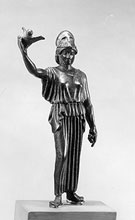Small bronze statuettes often had dedicatory inscriptions. They come from the great Panhellenic shrines - Dodona, for instance, or Delphi, or Olympia. Often they are dedications by athletes who had won in the Games, or else works made as a tithe of the dedicator's income. A number of them were found on the Athens Acropolis. During the Archaic period they followed local types, but in the Classical period they recapitulated more widespread types established in large plastic art. Commonest are figures of athletes, women and gods. The figures of gods seem more conservative in their development, having been influenced by the types for cult statues. Many of these statuettes can be seen to have been influenced by, even copied from, works by Polyclitus, Praxiteles, or Scopas. More often than not they were made by the cire perdue process. In some cases eyeballs of ivory or silver were inserted.
It was only natural that at Athens the commonest types should have been those of Athena. 'Athena with the Owl' was one which made its debut not long after the middle of the 5th century. The important role of Athenian craftsmen is confirmed by a bronze statuette workshop excavated in the Agora; and by the way in which workshop output matched the requirements of the great temples. Statuettes of precious metal were very rare; but a superb exception was the series of ten gold Victories (one per tribe) dedicated at the Acropolis to celebrate the victory over the Persians. |
 |